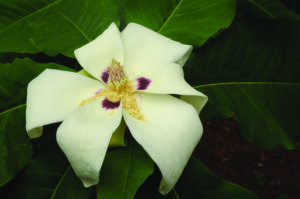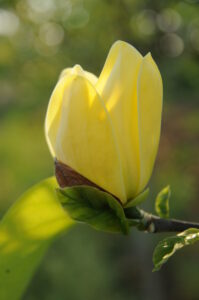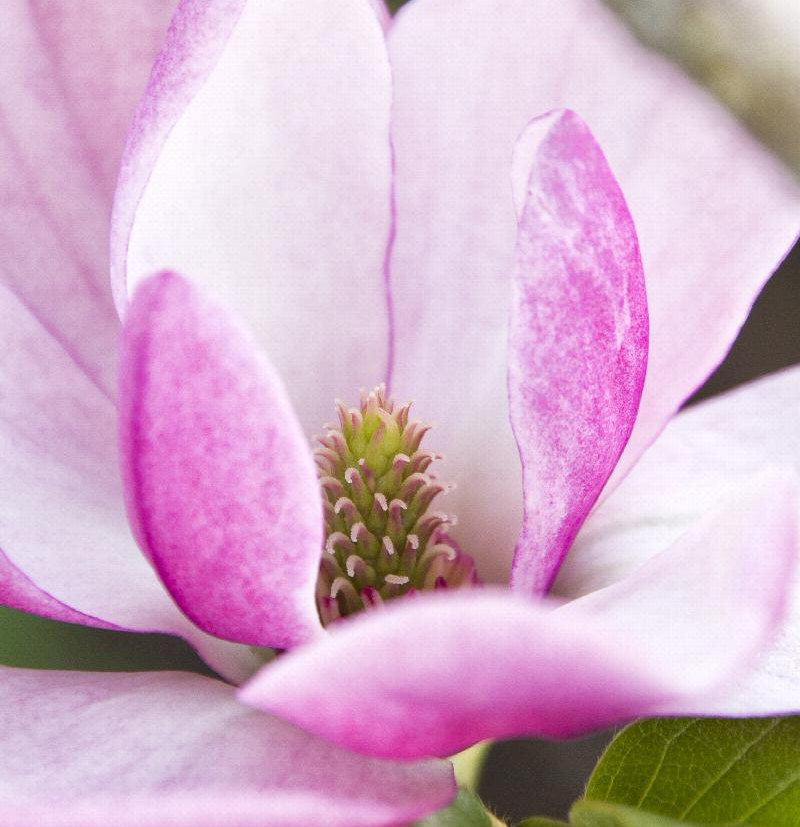A rainbow of flowering deciduous hybrids makes this tree a perennial favorite
Magnolias have remained popular the past few years, thanks to the introduction of new deciduous magnolia hybrids that have added more vivid colors, smaller sizes and precocious flowering (first flowers emerging before the leaves).
White-to-pink magnolias
Stephanie Mack, buyer at Portland Nursery, knows exactly when magnolias are in bloom because customers come in asking for them by name, especially saucer magnolias (Magnolia × soulangeana). “They are so spectacular and early,” she said.
Mack said customers are typically drawn to the deciduous varieties because almost all are fragrant, have no disease problems in Oregon, are adapted to acidic soils, and are less brittle than evergreen magnolias.
 The tropical-looking Magnolia macrophylla ssp. ashei (10–15 feet tall by 8–10 feet wide, zones 6–9), with its 2-foot-long leaves and big white, fragrant flowers that can reach 8 inches across, gets everyone excited at the nursery. “When they start to leaf out, the staff members go crazy about them,” Mack said.
The tropical-looking Magnolia macrophylla ssp. ashei (10–15 feet tall by 8–10 feet wide, zones 6–9), with its 2-foot-long leaves and big white, fragrant flowers that can reach 8 inches across, gets everyone excited at the nursery. “When they start to leaf out, the staff members go crazy about them,” Mack said.
For its outstanding form, Nicholas Staddon, plantsman and company spokesman with Everde Growers, a wholesale grower with 15 farms in Oregon, California, Florida and Texas, recommends the hybrid M. ‘Athene’ (M. ’Mark Jury’ × M. soulangeana ‘Lennei Alba’, zones 7–9, 13 feet tall by 10 feet wide). ‘Athene’ is a vigorous, upright, medium-size, vase-shaped tree that blooms at three years with fragrant cup-and-saucer white tepals showing a distinct violet-pink base.
“It may be as perfect a magnolia as you get to see,” Staddon said. “The form of the flower has great substance, with big petals that are interwoven and support each other.”
Nonetheless, Alexandrina hybrid saucer magnolia (Magnolia × soulangeana ‘Alexandrina’, zones 5–9, 20–25 feet tall and wide) is Staddon’s first love in magnolias. A smaller, shrubby or rounded tree that dates back to 1831 and is still widely popular, ‘Alexandrina’ bears fragrant 8-inch goblet-shaped blooms, white with a purplish base, that herald the start of spring, Staddon said, and fall too, as the leaves turn shades of yellow in colder weather before dropping.
Black-to-red magnolias
Black Tulip™ (Magnolia × soulangeana ‘Jurmag1’ PPAF, zones 5–9, 15–20 feet tall by 6–10 feet wide) is one of the most popular magnolias thanks to its dramatic, fragrant, deep purple goblet-shaped blooms.
Mack at Portland Nursery named it as a customer favorite in addition to the fragrant and large-flowering Magnolia × ‘Vulcan’, zones 5–9, 10–15 feet tall and wide.
“Any magnolia that has a deep flower color attracts customers,” Mack explained. ‘Vulcan’ magnolia flowers emerge on bare branches, reach 10 inches and are a solid deep magenta, with no white.
Mack is also excited about the newer ‘Genie’ (M. soulangeana × liliflora ‘Genie’ PP20748, zones 4–9, 5–6 feet wide by 10–13 feet tall). ‘Genie’ has the big, wide-petaled flower show of M. soulangeana in a compact, columnar size. Also, ‘Genie’ blooms at a younger age so it’s almost always sold with flower buds.
Yellow magnolias
 Of the top eight sellers at Heritage Seedlings, a wholesale grower of deciduous trees in Salem, Oregon, four are yellow magnolias, said co-owner Mark Krautmann. Two are long-established: M. ‘Butterflies’ (zones 4–9, 15–20 feet tall × 10–15 feet wide), and M. × brooklynensis ‘Yellow Bird’ (zones 4–8, 20–40 feet tall × 10–15 feet wide).
Of the top eight sellers at Heritage Seedlings, a wholesale grower of deciduous trees in Salem, Oregon, four are yellow magnolias, said co-owner Mark Krautmann. Two are long-established: M. ‘Butterflies’ (zones 4–9, 15–20 feet tall × 10–15 feet wide), and M. × brooklynensis ‘Yellow Bird’ (zones 4–8, 20–40 feet tall × 10–15 feet wide).
The other two are M. ‘Sunsation’ (zones 4–9, 20 feet tall × 10 feet wide), with a pinkish-red base on the inside of the flower against a strong yellow, and M. ‘Judy Zuk’ (zones 5–9, 20–28 feet tall × 6–8 feet wide), a somewhat columnar tree with 7–8-inch tulip-shaped, fragrant blooms in deep yellow with tinges of pink.
In addition, Krautmann singled out Honey Tulip™ (Magnolia ‘JURmag5’, zones 5–9, 10–13 feet tall by 10 feet wide). It has the same 6-inch goblet-shaped flower form as ‘Black Tulip’, with a softer yellow that is a “unique color” and more pastel than some of the other yellows.
‘Honey Tulip’ also is also unusual because it flowers on bare wood, unlike most yellow hybrids, which flower with their foliage.
“The yellow-flowered magnolias are really pretty and interesting, an unexpected flower color,” Mack said. “M. ‘Butterflies’ tends to hold its flower color really well; it doesn’t fade quickly. Customers ask for it by name, as well as ‘Yellow Bird’ and ‘Sunburst’,” she added.
With this vivid palette, it’s no wonder Magnolias, which have been around for millions of years, continue to be so popular.
Tracy Ilene Miller is a freelance writer and editor who covers several topics, including gardening. She can be reached at TMillerWriter@Gmail.com.

